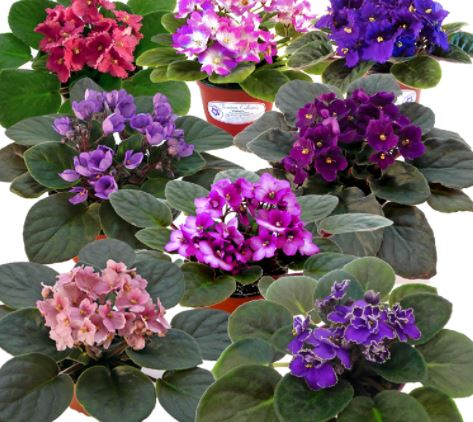How to Keep African Violets Thriving in Australia
Here are our tips on how to keep your African Violet Gifts happy and alive for months or years!
African violets (Saintpaulia) are beloved for their beautiful blooms and vibrant foliage, making them a popular houseplant choice. While they are native to Tanzania, these delicate plants can thrive in Australia with the right care. Below, we’ll explore how to nurture African violets and keep them healthy and blooming throughout the year in Australia’s unique climate.
1. Understanding the Ideal Environment
African violets thrive in a consistent, controlled environment. In Australia, where temperatures can vary greatly depending on the region, it’s important to recreate the moderate, humid conditions they love.
- Temperature: African violets prefer temperatures between 18°C and 24°C. Avoid exposing them to temperatures below 16°C or above 28°C, as extreme temperatures can stunt growth and damage the plant.
- Humidity: These plants love humidity. A range of 40-60% humidity is ideal, so consider using a humidity tray or placing them in rooms like kitchens and bathrooms, which naturally have higher humidity levels.
2. Location and Light
Light is one of the most crucial factors in keeping African violets healthy. In Australia, with its abundance of sunlight, choosing the right spot for your plant is essential.
- Indirect Light: African violets prefer bright, indirect light. Too much direct sunlight can scorch their delicate leaves. Place them near a north- or east-facing window for soft, filtered light.
- Artificial Light: If natural light is insufficient, especially during winter or in homes with limited natural light, fluorescent lights or LED grow lights can work wonders. Ensure the light source is placed about 30 cm above the plant and left on for 12-14 hours a day.
3. Watering the Right Way
African violets can be sensitive to water, and improper watering is a common reason they fail to thrive. Australia’s varying climate conditions mean you’ll need to monitor their watering needs carefully.
- Bottom Watering: The best way to water African violets is from the bottom. Place the pot in a shallow tray of water and allow the plant to absorb the moisture through its roots. This method helps prevent water from sitting on the leaves, which can lead to rot and fungal diseases.
- Watering Schedule: Water when the soil feels dry to the touch. African violets don’t like to be overly wet or dry, so striking a balance is key. In warmer months, they may need more frequent watering.
- Use Room Temperature Water: Cold water can shock the roots, so ensure the water is at room temperature.
4. Soil and Potting
African violets need well-draining soil to avoid waterlogging, which can cause root rot.
- Soil Mix: Use a special African violet soil mix or create your own by combining peat moss, perlite, and vermiculite. These materials help the soil retain moisture without becoming soggy.
- Repotting: African violets benefit from being repotted once a year. Choose a slightly larger pot, but be mindful that they prefer slightly smaller pots where they feel snug, as this encourages blooming.
5. Feeding Your African Violets
To maintain vibrant blooms, African violets need regular feeding.
- Fertilizer: Use a balanced, water-soluble fertilizer specifically formulated for African violets. Fertilize every 4-6 weeks, especially during their active growing period in spring and summer. Avoid over-fertilizing, as this can lead to poor growth and reduced blooming.
6. Managing Pests and Diseases
African violets are relatively pest-resistant but can still fall victim to common houseplant pests like aphids, mealybugs, and spider mites.
- Pest Control: If you notice pests, treat your plant with insecticidal soap or neem oil. Keep an eye out for webbing, discolored leaves, or small bugs on the underside of the leaves.
- Leaf Diseases: Fungal infections like powdery mildew can affect African violets, especially if the air is too humid or water sits on the leaves. Increase airflow around the plant and avoid splashing water on the foliage.
7. Encouraging Blooming
African violets are known for their continuous blooms when well-cared for. Here are some tips to encourage blooming:
- Adequate Light: Ensure your plant receives enough indirect light, as insufficient light can prevent blooming.
- Proper Feeding: Regular feeding with the right fertilizer promotes flower production.
- Leaf Pruning: Remove any spent flowers and yellowing leaves to redirect the plant's energy toward new blooms.
8. Caring for African Violets in Australia’s Varied Climates
Australia’s climate can be hot and dry, especially in areas like Queensland and Western Australia. If you live in a region with extreme heat, keeping your African violets in a climate-controlled room will help them thrive. In cooler regions, ensure they are protected from cold drafts and sudden temperature drops.
Conclusion
With the right environment, careful watering, and regular feeding, African violets can thrive beautifully in Australia. Whether you’re a novice or experienced gardener, these stunning plants are well worth the effort, rewarding you with vibrant, long-lasting blooms year-round. By following these tips, you’ll enjoy the beauty of African violets for many years to come.
Explore Popular Articles
Get Well Fruit Hampers and Fruit Baskets
Our range of get well fruit hampers and baskets make the perfect gift to put a smile on that special...
10 Perfect Gifts for the Woman Who Has Everything | iGift® Hampers
10 Perfect Gifts for the Woman Who Has Everything Finding the right present can be tricky—especially...
Top 10 Thank You Gifts to Show Your Appreciation
When words aren’t enough, a thoughtful thank you gift is the perfect way to show your gratitude. Whe...
Gifts For Dad Who Wants Nothing
Gifts for Dad Who Wants Nothing – 10 Thoughtful Ideas He’ll Actually Love Some dads say they don’t w...
Fruit Hampers vs Fruit Baskets – What’s the Difference?
When you’re searching for the perfect gift, two options often come up: fruit hampers and fruit baske...
Hospital Delivery NSW
We deliver to all New South Wales - NSW hospitals. Public and private. Please make sure your recipie...



